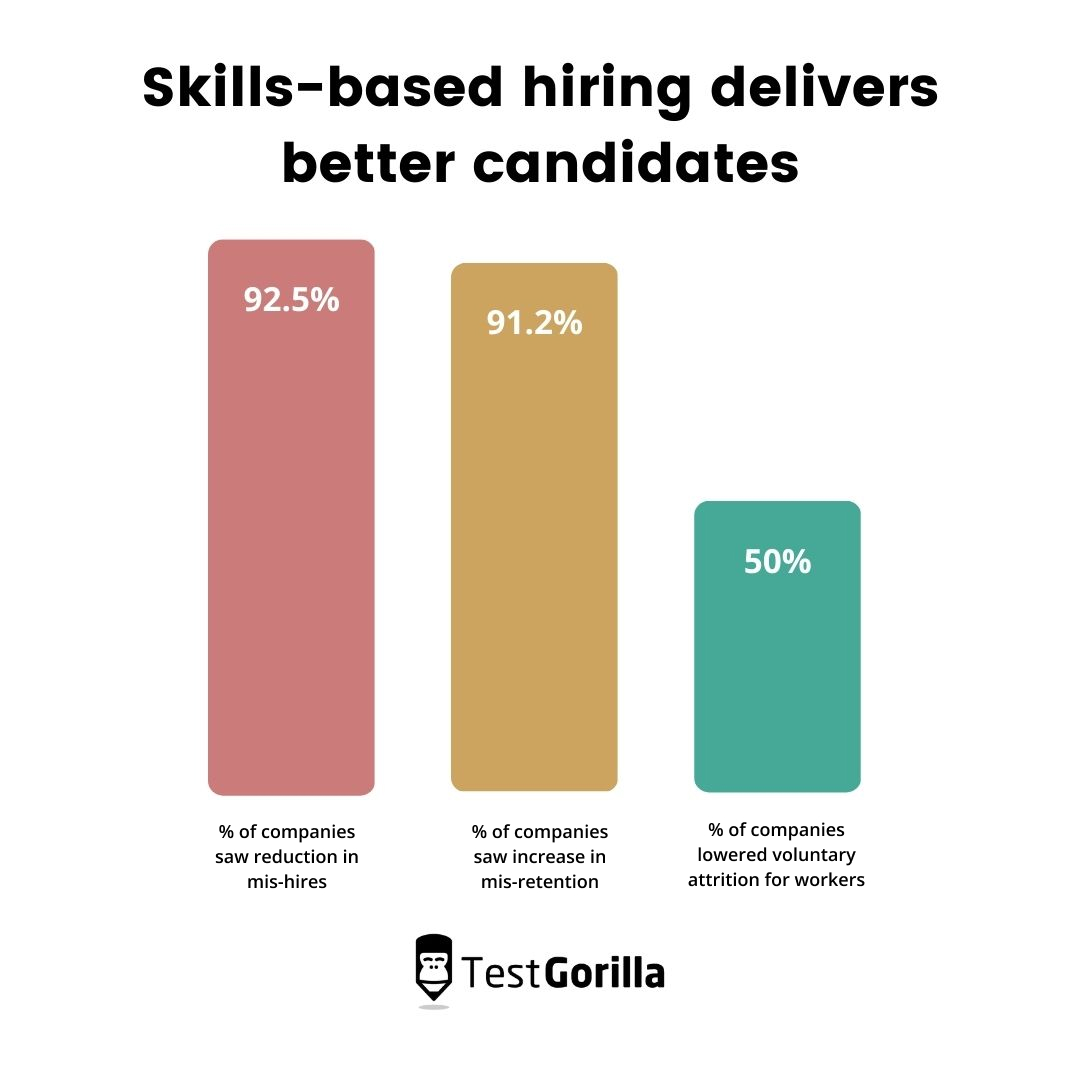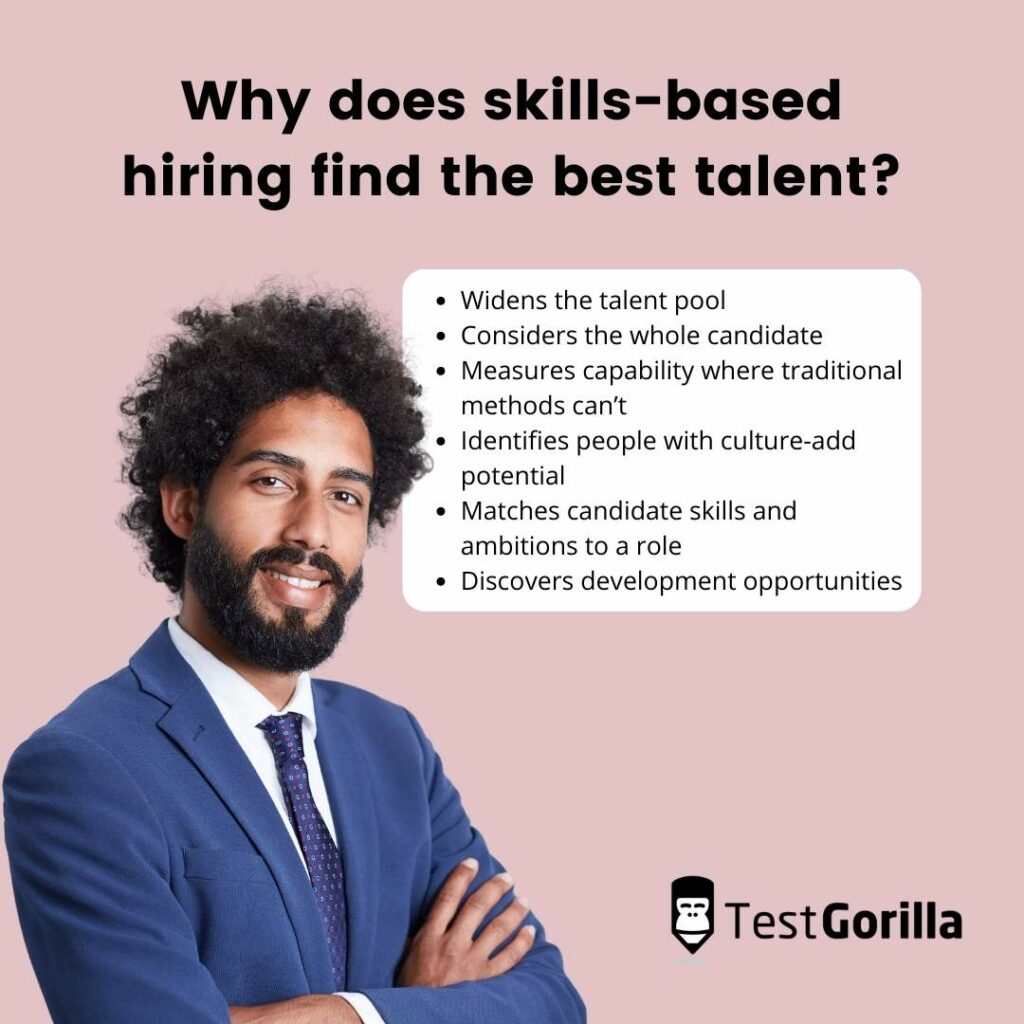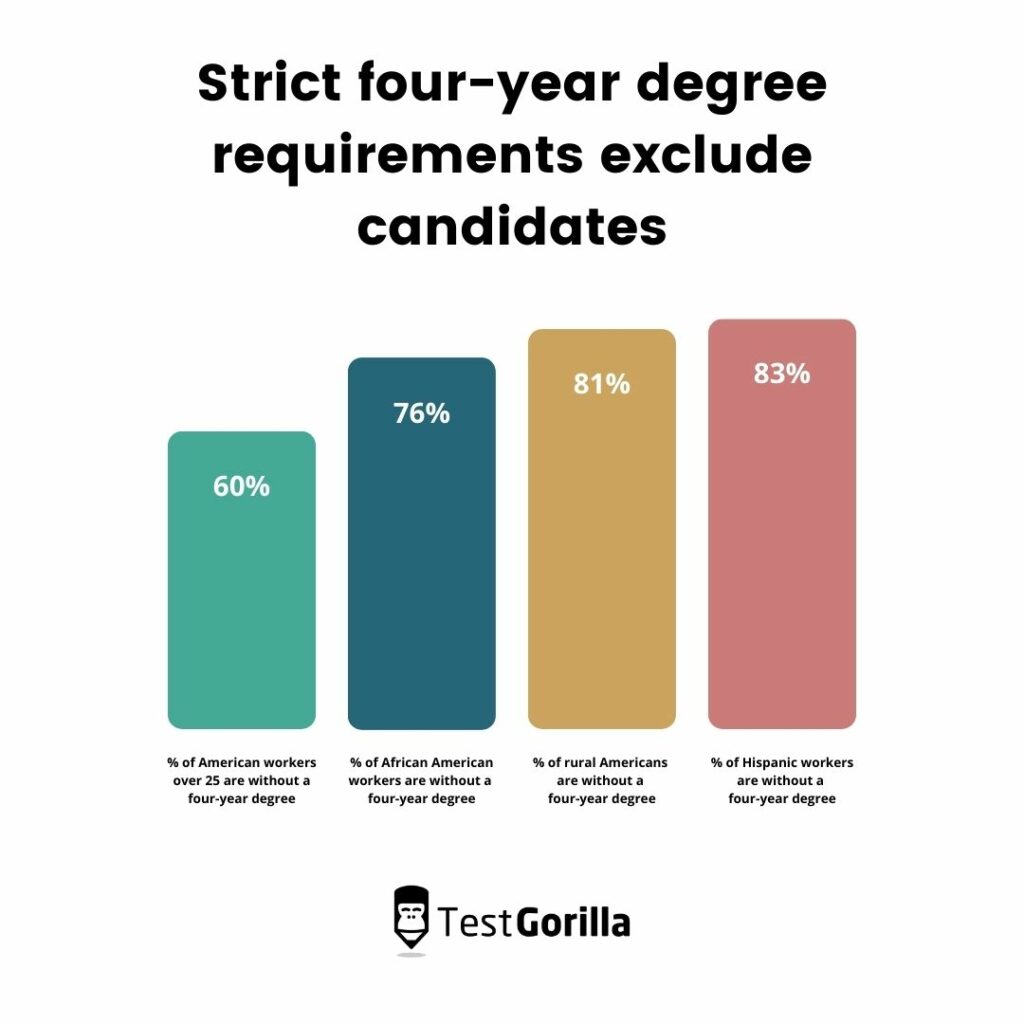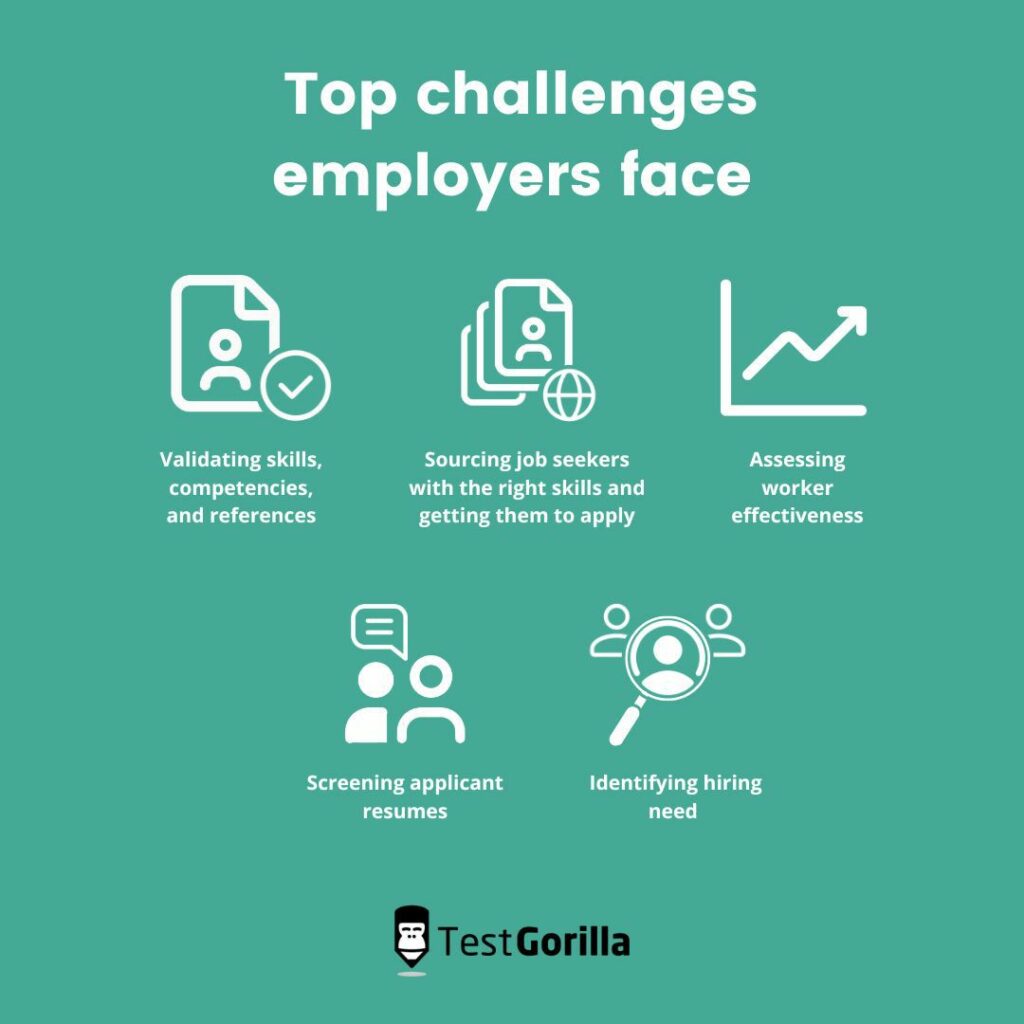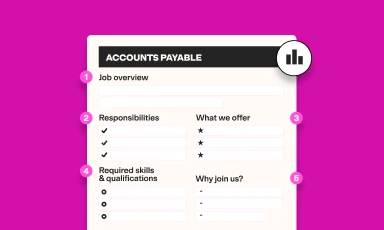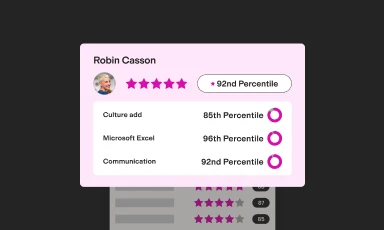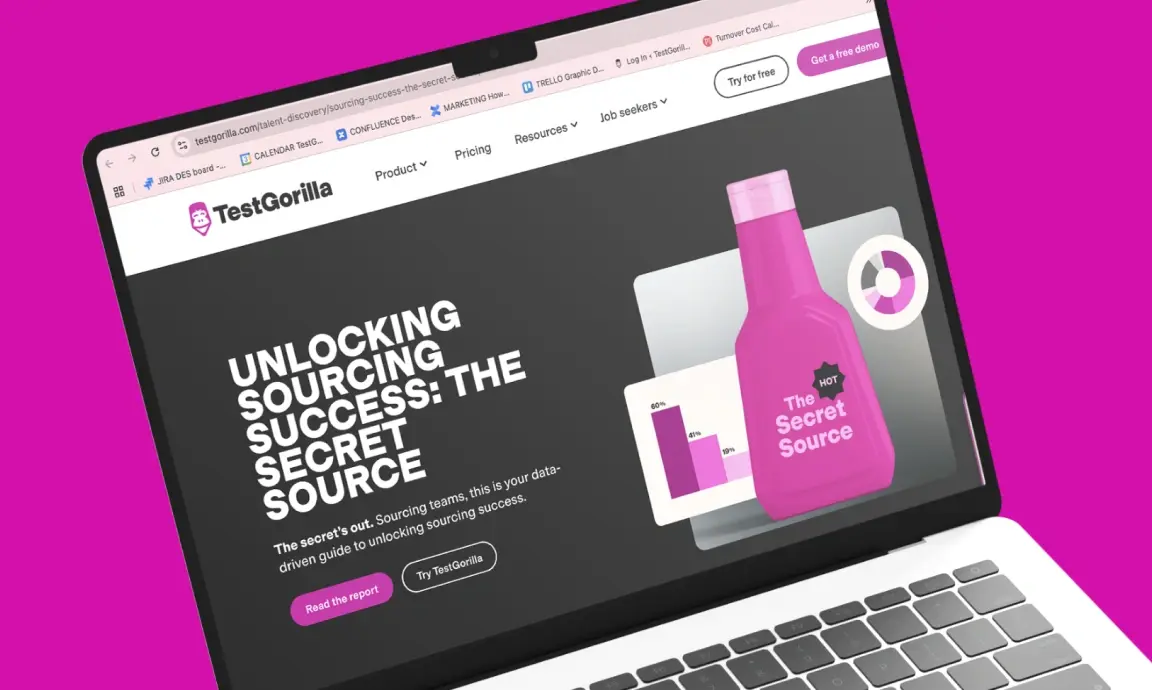Why does skills-based hiring deliver better candidates?
When you need the best candidate for a role, there’s a lot standing in your way. Years of work experience, the “right” educational requirements, a well-written resume…
And we haven’t even gotten to the skills they need to perform the job well.
Increasingly more people say that skills-based hiring is the future. It bypasses all these tedious steps and produces quality results – identifying stellar candidates who can get the job done.
But why does skills-based hiring deliver better candidates?
Skills-based hiring removes restrictions, widening the talent pool to help you find the right person. Then, by focusing on skills, you ensure that applicants are a perfect fit.
However, there’s much more to it.
Let’s dive into why the skills-based hiring process produces better results and stronger candidates, using real objective data and success stories.
Companies need better hires more than ever
Employers are rethinking their hiring strategies after a series of impactful events drastically changed the working landscape, such as the pandemic and The Great Reshuffle.
Attrition is high, employees are seeking fulfillment in different roles, and HR professionals need to retain talent through economic uncertainty.
Companies need a wider talent pool with more and better applicants. This means they have to move beyond degree requirements, specific job titles, years of work experience, and looking for “good” company names on resumes.
Due to The Great Reshuffle, employers also need to secure top talent that might be career-switching. Many workers are leaving their positions to pursue their dream roles, and that could be an unconventional switch – from sales to accounting, for example.
Unfortunately, traditional hiring practices fail to facilitate this switch from one industry to another.
The current market climate has led thousands of organizations to switch to skills-based hiring to secure much-needed talent (and retain it, too).
According to our State of Skills-Based Hiring report, 76% of employers used skills-based hiring in 2022.
Skills-based hiring widens the talent pool, focuses on candidates’ raw capabilities, and discovers untapped and nontraditional talent.
We need to focus on these points if we want to flourish through these difficult times and continue to attract and retain the best candidates.
Skills-based hiring delivers better candidates
It isn’t simply that skills-based hiring helps HR professionals through a tough economic time.
Skills-based hiring delivers candidates who are better suited to their roles, perform better, and are looking to grow continuously.
Our State of Skills-Based Hiring report discovered some remarkable points which demonstrate the power of skills-based hiring. Of the employers we surveyed that are using it:
92.5% saw a reduction in mis-hires
91.2% saw an increase in retention
50% lowered voluntary attrition for workers
Emma McFetridge, a talent acquisition professional interviewed by TestGorilla, says her company experienced these benefits first-hand.
Emma says that they’ve drastically reduced their number of mis-hires using skills tests and skills-based hiring. When they had recruited without skills assessments, they noticed a large number of candidates weren’t able to accurately assess their own capability.
These candidates weren’t as skilled as they claimed, whether through intentional deception, or a lack of self-awareness.
Skills testing is an objective process, so whether the candidate knows their skill level or not, the test shows the truth.
This is particularly helpful for discovering amazing candidates with impostor syndrome, who underestimate their own skills.
Skills-based hiring is gaining traction quickly, with some major names supporting it, including Walmart, IBM, Apple, and Google.
Companies like IBM are stripping degree requirements from their job descriptions, instead assessing skills and allowing candidates to simply attend tech boot camps.
But skills-based hiring is reaching more than just individual organizations; it’s reaching entire regions.
In 2022, the state of Maryland teamed up with workforce development non-profit Opportunity@Work to remove college degree requirements from nearly half of its job roles.
This act opened thousands of jobs in healthcare, policing, engineering, and more to a wider talent pool.
Byron Auguste, the chief executive of Opportunity@Work, says degrees should be required for certain medical positions or for designing bridges. But when it comes to managers, sales representatives, or marketers, degree requirements make no sense.
Jozefina Hoswza, a TestGorilla employee, is a great example of the success of skills-based hiring.
Jozefina started in customer success and quickly moved into a UX researching role – all because of skills-based hiring.
She believes that a great deal of skills-based hiring’s success is due to giving candidates time. You don’t need to rush and grab a degree at age 18 that decides your entire future. “A lot of stress comes with deciding what to study when you’re 18 or 19. That decision shouldn’t determine what you do for the rest of your life – you need to explore your skills.”
Skills-based hiring gives candidates the chance to steadily build a strong arsenal of skills and discover their true passions.
The best insights on HR and recruitment, delivered to your inbox.
Biweekly updates. No spam. Unsubscribe any time.
Traditional hiring is hindering hiring efforts, not helping
Skills-based hiring is an effective method that leads to better outcomes – but this isn’t the only reason it’s the future of hiring. The truth is, traditional hiring methods are actually hurting hiring efforts.
Traditional hiring methods are a thing of the past. Resumes don’t indicate performance and degree requirements are slowing your hiring process down and narrowing your talent pool.
Degree inflation hurts both companies and candidates. A study done by the Harvard Business School found that, in 2015, 67% of production supervisor job postings asked for a college degree, and only 16% of currently employed production supervisors had one.
The same study found that only one-third of Americans hold a four-year degree.[1]
In this current landscape, most jobs require regular upskilling to make sure employee skill sets remain relevant, which means job requirements change frequently.
What’s the point of requiring the “right” experience if the goalposts keep moving?
If job roles need to be upskilled regularly anyway, we believe it’s best to relax strict requirements and hire someone who has the right core skills, then fill in any gaps with training.
Traditional hiring is less efficient and impacts a worker’s chances of finding a good job to match their skills. It hurts employers, too: Reliance on experience and degrees gets in the way of finding the best candidates.
Why does skills-based hiring find the best talent?
Skills-based hiring finds untapped talent, verifies skills, and helps hiring managers to find the best candidate for the role.
Accurate skill evaluation widens the talent pool for hiring managers, empowering them to find real gems. After all, capability is more than just professional certification and experience.
These methods deliver the best candidates because skills-based hiring:
Widens the talent pool
Considers the whole candidate
Measures capability where traditional methods can’t
Identifies people with culture-add potential
Matches candidate skills and ambitions to a role
Discovers development opportunities
1. Widens the talent pool
The chances of finding stellar talent increase when you expand your talent pool. Skills-based hiring turns your pool into an ocean.
Skills-based hiring expands your talent pool by:
Reducing reliance on work history and years of experience
Encouraging marginalized groups to apply
Encouraging candidates with career gaps to apply
Facilitating career switching between industries
Reducing reliance on college degrees
The last point alone makes a huge difference. Thousands of candidates don’t possess four-year degrees, particularly underrepresented groups, making this a detriment to your DE&I initiatives.
Strict four-year degree requirements are excluding these candidates:
60% of American workers over the age of 25 don’t hold a four-year degree
76% of Black American workers don’t hold a four-year degree[2]
81% of rural Americans don’t hold a four-year degree[3]
83% of Hispanic workers don’t hold a four-year degree[2]
Disabled employees are also much more likely to lack traditional job requirements, such as an extensive work history and college education.
This is one of the reasons why only 29% of autistic adults are employed, despite a strong desire to work.[4]
When you drop unnecessary requirements and rely on demonstrable skills instead, you open your talent pool to include millions of disabled workers.
For more information on this topic, check out our article on the ASD employment gap.
2. Considers the whole candidate
Skills-based hiring considers everything a candidate brings to the table, not just work history and education.
Skills tests enable employers to assess candidates’ technical skills, soft skills, language proficiency, and how well they identify with your values and culture.
Alan Price, a member of the Forbes Human Resources Council, believes that you need to assess everything a candidate brings to the table to make a good hire.
Alan believes that potential, a willingness to learn, and solid transferable skills are just as, if not more, important than education.
The traditional process struggles to correctly verify technical skills, let alone identify soft skills like:
When you can’t evaluate the candidate as a whole, you can’t accurately measure their role capability.
For example, Erica Nunez, an engineering manager at TestGorilla, struggled to write a good resume due to her colorful mixture of hard and soft skills.
Her communication and presentation skills were just as important as her technical skills, but she was stumped about how to write a resume that married these varied skills and made her look like an appealing candidate.
Traditional hiring practices bypass a wealth of talent and skill because they fail to assess the entire candidate. If you dismiss somebody because they didn’t go to a reputable school or work for a company you recognize, you’re missing out.
For more information on evaluating the candidate as a whole, read our article on skills testing as a part of the holistic hiring process.
3. Measures capability where traditional methods can’t
Despite being supposedly “tried and true,” traditional hiring methods are not airtight.
Just because we’ve used them for decades doesn’t mean these methods don’t have their flaws. According to McKinsey, the top challenges employers face in a traditional hiring process are:
Validating skills, competencies, and references
Sourcing job seekers with the right skills and getting them to apply
Assessing worker effectiveness
Screening applicant resumes
Identifying hiring need
The same survey showed that these HR professionals are mainly apprehensive to take on a skills-based approach because they aren’t confident in their ability to identify capability without a resume.
But the people using resumes aren’t confident either. In our own survey on resume effectiveness, 56.9% of HR professionals said that they couldn’t tell if a candidate had the right skills by reading their resume.
In fact, relying solely on resumes can lead to disastrous outcomes, including hires that lack key skills, disrupt your company culture, and cost you thousands of dollars.
For more on this, read our 5 stories from resume recruiting hell.
4. Identifies people with culture-add potential
Employees want a culture that suits them. It makes them more comfortable where they are, increases morale, and boosts teamwork.
Culture is the number one job satisfaction factor in all industries but one, and it’s easy to see why.
Skills-based hiring doesn’t just find successful candidates, it finds successful long-term employees who help your company culture flourish.
Evaluating personality and culture enables you to find employees who flourish in your environment, support your values, and complement current employees.
Tests, like our Culture Add test, assess a candidate’s values and behavior, so you bring like-minded people into your culture without relying on “culture fit.”
We believe in culture add over culture fit, which means a candidate holds similar views that align with your organization’s values, but you don’t look for a perfect fit.
Culture fit can eventually lead to a homogenous workplace where every employee has to “fit perfectly.” Culture add, on the other hand, naturally increases diversity.
This diversity creates a healthier, happier workplace, which produces better results.
For more information, read our blog post on the benefits of diversity in the workplace.
5. Matches candidate skills and ambitions to a role
When a candidate’s skills and capabilities match your open role, you end up with a happier and more competent employee.
Skills-based hiring connects candidates to roles that match their skill sets and ambitions, leading to happier employees who simply perform better.
Our State of Skills-Based Hiring report showed that 72.1% of people hired via skills-based hiring are happy in their roles. It also showed that 54.3% of candidates prefer skills-based hiring.
With skills-based hiring workers get a chance to display their skills and do what they’re good at.
Skills-based hiring also enables candidates to make jumps between industries. This means that an employee doesn’t have to stagnate in a marketing role just because they have a marketing degree.
They can move to any industry they like and flourish, increasing satisfaction and retention.
For more insights, read our article on skills-based hiring from a candidate’s perspective.
6. Discovers development opportunities
Skills testing does more than show you what a candidate is great at – it also shows you where they need improvement.
The results of a skill assessment might show that a candidate needs to develop in one or two areas. In traditional hiring, you’d only realize this after a few weeks or months of on-the-job experience.
Knowing areas for improvement means you can make targeted efforts in learning and development from day one.
For example, you could help the employee build a professional development plan, which lays out an employee’s goals and how they’re going to achieve them.
Skills-based hiring not only benefits the initial hiring process but also perpetuates a culture based on continuous improvement.
Employees are much more eager to continue growing their skills, and this leads to more high-quality, motivated workers who are ready and willing to take their careers to the next level.
Workers hired through skills-based hiring aren’t content resting on their laurels and are always hungry for the next challenge.
Use skills tests to hire the best candidates
We aren’t blowing smoke when we say that skills-based hiring is the future of employment.
Skills-based hiring delivers better candidates than traditional methods. You discover untapped talent from nontraditional backgrounds, people who weave into your culture and share your values, and candidates who are eager to develop and learn.
Ready to adopt skills-based hiring and kick the resume to the curb? Check out our article on how to write job descriptions that speak to a skills-based hiring approach.
Sources
“Dismissed by Degrees”. (December 13, 2017). Harvard Business School. Retrieved February 22, 2023. https://www.hbs.edu/managing-the-future-of-work/Documents/dismissed-by-degrees.pdf
“Highest Educational Levels Reached by Adults in the U.S. Since 1940”. (March 30, 2017). Newsroom. Retrieved February 22, 2023. https://www.census.gov/newsroom/press-releases/2017/cb17-51.html
Marré, Alexander. “Rural Education at a Glance, 2017 Edition”. (April 2017). U.S. Department of Agriculture. Retrieved February 22, 2023. https://www.ers.usda.gov/publications/pub-details/?pubid=83077
“Outcomes for disabled people in the UK: 2021”. (February 10, 2022). Office For National Statistics. Retrieved February 22, 2023.
You've scrolled this far
Why not try TestGorilla for free, and see what happens when you put skills first.


